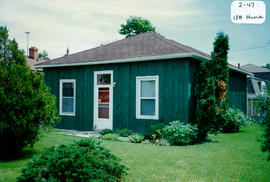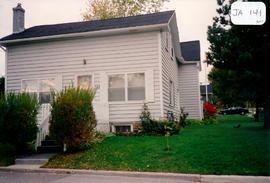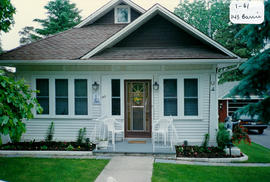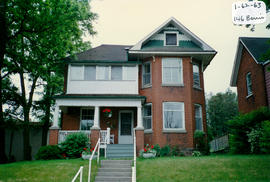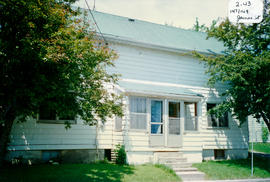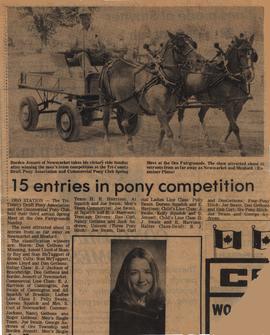This is the front view of the house located mid-block on the east side at 143 Barrie Street. It was the last house built by Art, Tom and Len Saint after WWI. The building was constructed in 1925 in the Arts and Crafts style. It became the home of many people, including Erv Hill and his wife. He worked for Dennis Nolan and was a noted (Ford) mechanic. Harold Seaurow and his wife (who came from Grand Valley) later bought and moved into this house. Harold was a car salesman and a partner with Wink Crake for a while. He then went with Jim (Catania) and Brad Walker.
The 1½-storey ‘bungalow’ has an asymmetrical façade and a rectilinear plan. A broad, medium-pitched, gabled hip roof extends down to reduce the scale of the building. The slightly-raised porch is entered from the front. The roof, horizontal siding, and a wide band of windows across the front of the porch emphasize the horizontal lines and massing of the style. There are wide window openings with low floor to ceiling heights. Multiple, double-hung windows are set into wide segmented, arched openings with 1/1 panes, lug sills of precast concrete, and brick voussoirs at the arches. The smaller, second-storey windows are offset from the ground floor windows. They are set into a gable and dormers and have plain, wood sills and trim. A bay window projects out from the south wall and has no foundation. The house has wood frame construction with masonry cladding, vinyl siding and a painted, concrete foundation. The original siding would have been wood. According to the 2000 inventory, the house is in good condition with many original features that have been maintained well. It also notes that the windows, shutters, and porch railing are not original. (1, 2, 3)

